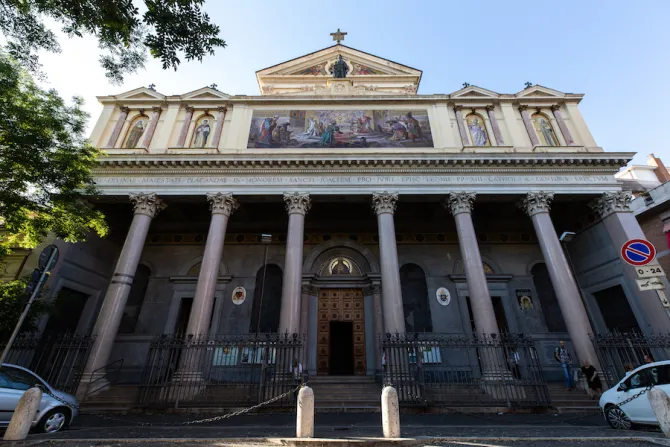Rome, Italy, Jul 22, 2020 / 14:21 pm
There are many Catholic churches in Rome, but few can boast of having been built through the contributions of Catholics around the world as a gift to the pope.
San Gioacchino ai Prati di Castello is an exception.
Sitting less than a mile from St. Peter's Basilica, San Gioacchino (St. Joachim in English), was built as a gift to Pope Leo XIII for the celebration of his 50th anniversary of priesthood.
The pope, whose birth name was Gioacchino Pecci, had expressed the desire for a church in Rome dedicated to his patron, since none yet existed. He put the project under the direction of a French abbot, Antonio Brugidou.
Brugidou purchased land in the area known as "the lawn of the castle" (so-called because it was an undeveloped area close to the monument of Castel San Angelo). As the neighborhood started to be populated in the 19th century, however, it needed churches; and San Gioacchino was one of the first to be built.
Construction was finished in just seven years and the church was dedicated August 20, 1898. San Gioacchino, which is still a pontifical church, was entrusted to the Redemptorists that same year, and in 1905 a parish was erected there by Pope Pius X.
At the appeal of Brugidou, Catholics from 27 countries donated generously to the building of a church Pope Leo XIII asked to be a permanent seat of reparatory adoration for Jesus in the Blessed Sacrament.
The names of these countries are inscribed on the inside of the church, over the entrance. Of these, 14 countries gave an exceptional amount and have chapels dedicated to them: Argentina, Bavaria, Belgium, Brazil, Canada, England, France, Holland, Ireland, Italy, Poland, Portugal, Spain, and the United States.
These national chapels are each decorated in a unique style. Most include images of saints from that country and images or statues of the Virgin Mary under a title commonly honored there.
Eucharistic symbols can be found around the church and in every chapel.
"This church was built precisely as the global seat of Eucharistic adoration," Redemptorist Fr. Piotr Sulkowski told CNA, adding that "everything here refers to the Eucharist."
In the sanctuary, above the main altar, sits a large Eucharistic throne of white marble used for solemn Eucharistic exposition. The large gold monstrance sits at the center on top of a globe flanked by angels holding candelabras.
The Spanish nation chapel is the site of daily adoration, which takes place, with some variation, from 8 a.m. to 11 p.m. "People come even from far away to pray in this chapel," Sulkowski, who is the pastor of San Gioacchino, said.
The chapel of the United States is one of the most beloved in the church, according to Sulkowski, because of the presence of a beautiful statue of the Immaculate Virgin Mary, to whom the Catholics of North America dedicated the chapel.
"Many people come there to pray [to Mary], whom they call, 'my Madonna.' It's a beautiful thing," he said.
(Story continues below)
Outside the church, atop the dome, sits a four-foot-tall iron monstrance. Sulkowski said this dome can be seen from the dome of St. Peter's Basilica and the apostolic palace and from other positions around Rome.
On the church's facade is a magnificent mosaic depicting adoration of the Eucharist by the Catholic world.
At the center of the image is the Eucharist in exposition upon an altar, surrounded by adoring angels. To the left is Pope Clement VIII in adoration and to the right is Pope Leo XIII, inviting to adoration the Catholics of the world, symbolized by five women who represent each of the five major continents.
Under the mosaic, words in Latin remind passersby of the reason for the church's founding: "orbis catholici romae juribus reparandis adoratio" – "Adoration in Rome by the Catholic world for the reparation of divine justice."
This article was originally published on CNA Aug. 1, 2019.



